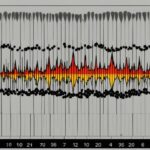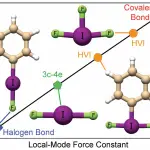Last Updated on 4 months by Francis
Have you ever wondered how infrared photons interact with molecules? Do they cause rotational or vibrational energy? In this article, we will explore the behavior of infrared photons and their properties.
Covalent bonds in organic molecules behave like springs, undergoing complex vibrations that can be quantized into rotational and vibrational modes. These vibrations are an essential part of the molecular structure and play a significant role in understanding the behavior of infrared photons.
In the electromagnetic spectrum, infrared photons match the frequencies of these vibrational modes, allowing them to be absorbed by molecules. This absorption results in an increase in vibrational energy and, subsequently, the release of energy as heat. By studying the behavior of infrared photons, scientists can gain insights into the molecular structure of compounds.
Contents
Key Takeaways:
- Infrared photons interact with molecules through rotational and vibrational energy.
- Covalent bonds in organic molecules undergo complex vibrations, which can be quantized into rotational and vibrational modes.
- Infrared photons are absorbed by molecules, leading to an increase in vibrational energy and the release of heat.
- Studying the behavior of infrared photons helps identify different functional groups in organic molecules.
- Understanding infrared photon behavior is crucial in various fields, from organic chemistry to atmospheric science.
How Infrared Spectroscopy Works
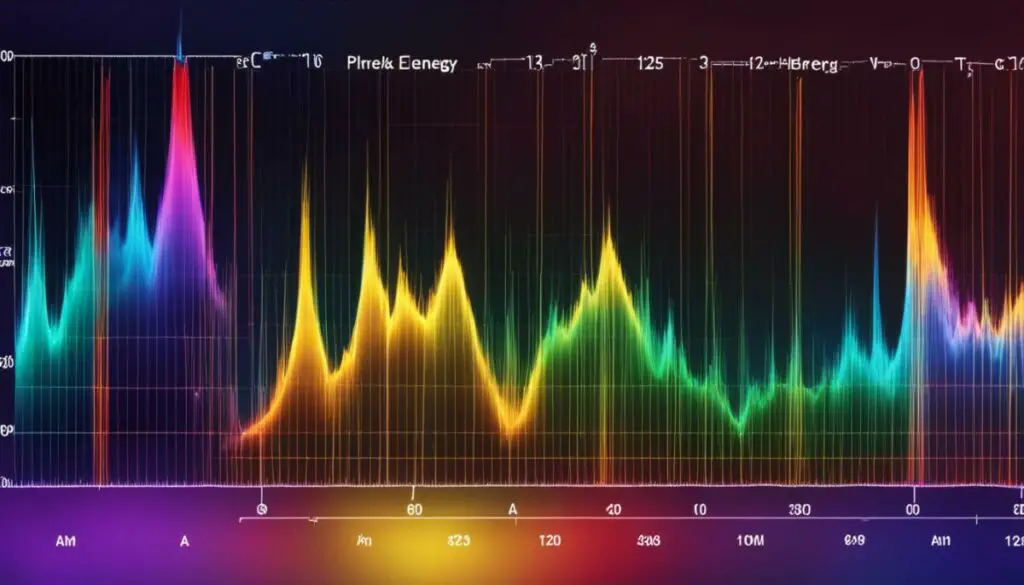
Infrared spectroscopy is a powerful analytical technique that utilizes infrared light to investigate the molecular composition of substances. It operates on the principle that different molecular bonds absorb specific frequencies of infrared radiation, resulting in characteristic absorption patterns.
When a sample is subjected to infrared light, some of the radiation is absorbed by the molecules present, while the rest passes through and reaches a detector. The absorbed frequencies correspond to the vibrational frequencies of specific chemical bonds in the molecules. By analyzing the absorbed frequencies, scientists can determine the types and quantities of different functional groups within the sample.
Infrared spectroscopy is widely used in various fields, including pharmaceuticals, forensics, environmental analysis, and materials science. It provides valuable insights into the molecular structure, chemical composition, and physical properties of substances.
Principles of Infrared Absorption
The absorption of infrared radiation by molecules occurs due to the vibrational motions of their atomic bonds. When the frequency of incident infrared radiation matches the natural frequency of a bond, the bond absorbs energy, resulting in its vibration or stretching.
The energy absorbed causes a change in the dipole moment of the molecule, which is a measure of its overall molecular polarity. This dipole moment change leads to characteristic absorption peaks in the infrared spectrum.
The following factors influence the intensity and position of the absorption peaks:
- The type of bond and its associated vibrational frequency
- The molecular structure and functional groups present
- The strength and dipole moment of the bond
Interpreting Infrared Spectra
The interpretation of infrared spectra involves identifying the absorption peaks and correlating them with specific functional groups or molecular bonds.
The table below provides some examples of common functional groups and their corresponding absorption peaks:
| Functional Group | Absorption Peak (cm-1) |
|---|---|
| Alcohol (-OH) | 3200-3600 |
| Carbonyl (C=O) | 1700-1750 |
| C=C double bond | 1600-1680 |
| C≡C triple bond | 2100-2260 |
By comparing the absorption peaks observed in the spectrum with known absorption data, scientists can identify the functional groups present in a compound and gain insights into its structure and composition.
Vibrational Modes in Organic Molecules

Organic molecules exhibit various vibrational modes, including stretching and bending vibrations. Stretching vibrations involve changes in the interatomic distance along the axis of a bond, while bending vibrations involve changes in the angle between bonds.
For example, let’s consider the vibrational modes of the carbonyl bond in a ketone molecule. In this case, the carbonyl bond undergoes a stretching motion, where the distance between the carbon and oxygen atoms changes periodically.
These vibrational modes are crucial in understanding the behavior of organic molecules and their interaction with infrared (IR) light. When IR light is passed through a sample, different functional groups and bonds absorb specific frequencies of light, which correspond to their vibrational modes. This absorption can be detected using infrared spectroscopy, allowing for the identification of functional groups in organic molecules.
Infrared spectroscopy relies on the fact that different types of bonds have characteristic vibrational frequencies. For example, carbon-carbon double bonds and carbon-carbon triple bonds have different stretching frequencies. By analyzing the absorption of different frequencies of IR light, scientists can determine the presence of specific bonds and functional groups in a molecule.
Let us take a look at how different vibrational modes and frequencies can be associated with specific functional groups in a table:
| Vibrational Mode | Functional Group | Vibrational Frequency (cm-1) |
|---|---|---|
| Stretching Vibration | Carbonyl Group (C=O) | 1600-1800 |
| Stretching Vibration | Carbon-Carbon Double Bond (C=C) | 1650-1690 |
| Stretching Vibration | Carbon-Carbon Triple Bond (C≡C) | 2100-2260 |
| Bending Vibration | Alcohol Group (O-H) | 3200-3550 |
| Bending Vibration | Amine Group (N-H) | 3510-3700 |
This table demonstrates how different functional groups exhibit distinct vibrational modes and frequencies. By analyzing the absorption peaks in the infrared spectrum, scientists can identify the presence of specific functional groups in a molecule, providing valuable information about its structure and composition.
Strength of Infrared Absorption
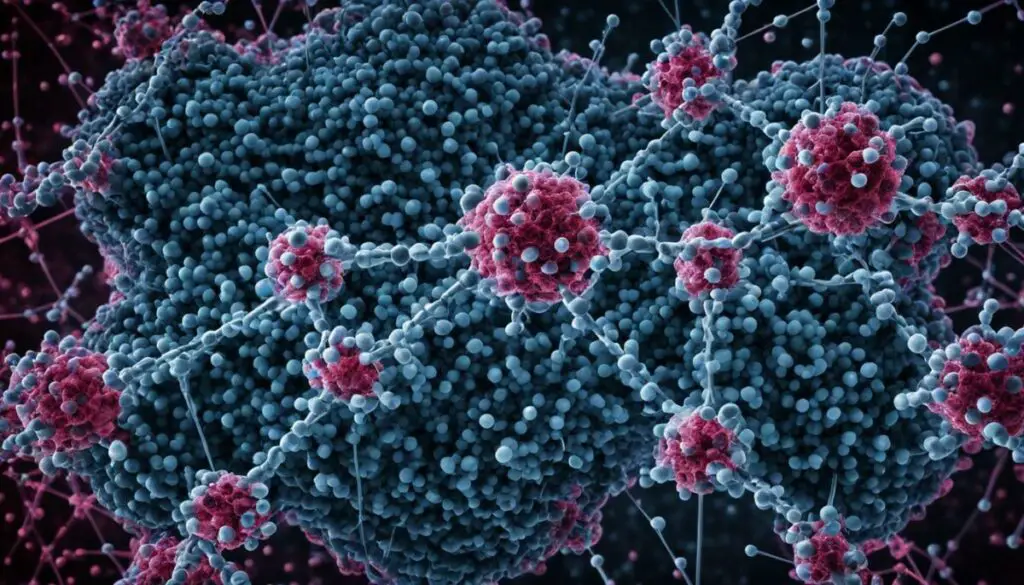
The strength of infrared absorption in molecules is influenced by the polarity of their bonds and the resulting change in dipole moment. It is an essential factor to consider when analyzing and interpreting infrared spectra. Polar bonds, such as carbonyl (C=O) bonds, exhibit a greater ability to absorb infrared light compared to nonpolar bonds like carbon-carbon triple (C≡C) bonds in alkynes.
Infrared active vibrations are molecular vibrations that result in a change in dipole moment and are capable of absorbing infrared light. These vibrations involve a shift in electron density, causing a temporary separation of positive and negative charges within a molecule. As a result, it creates a dipole moment and allows for the interaction with infrared radiation.
On the contrary, infrared inactive vibrations do not lead to a change in dipole moment and, therefore, do not absorb infrared light. These vibrations typically involve symmetric stretching or bending motions that do not cause a significant shift in electron density.
The concept of infrared absorption and the polarity of bonds can be understood through an analogy of pushing a swing. Just as pushing a swing requires a continuous input of energy at the right frequency to amplify the swing’s motion, polar bonds require the right frequency of infrared light to be absorbed and increase vibrational energy.
Table: Polarity of Bonds and Infrared Absorption
| Bond Type | Infrared Absorption |
|---|---|
| Polar bond (e.g., carbonyl) | Strong absorption of infrared light |
| Nonpolar bond (e.g., carbon-carbon triple) | Weaker absorption of infrared light |
Example:
“The presence of a highly polar bond, such as a carbonyl group, in a molecule can generate a strong absorption peak in the infrared spectrum. This allows chemists to identify the presence of specific functional groups and gain insights into the molecular structure.”
Understanding the strength of infrared absorption and the polarity of bonds is crucial in the interpretation and analysis of infrared spectroscopy data. This knowledge facilitates the identification of functional groups and provides valuable insights into the molecular properties of organic compounds.
Interpretation of IR Spectra
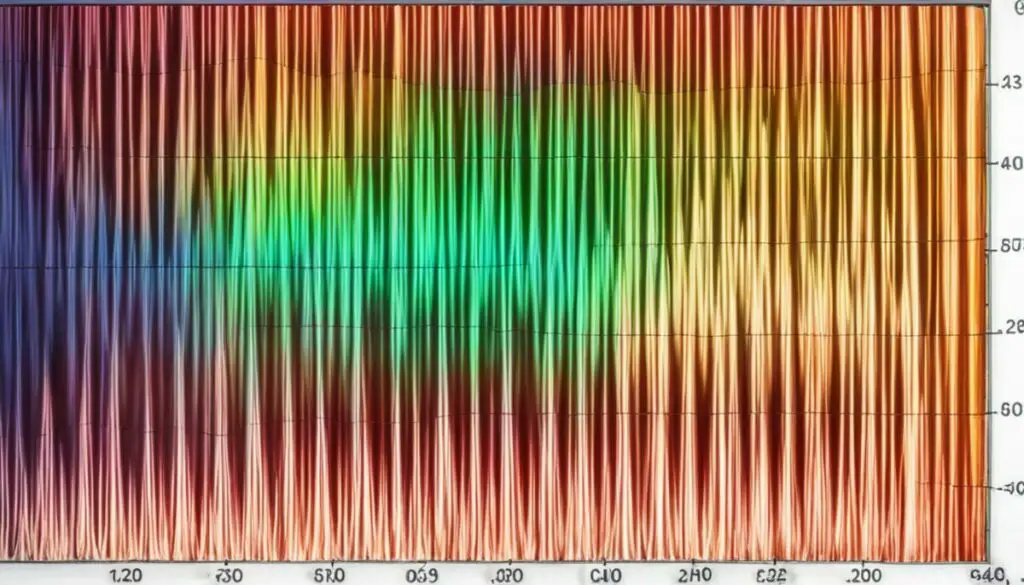
IR spectra provide valuable insights into the composition and structure of molecules by showcasing the absorption of infrared light. By analyzing the absorption peaks in an IR spectrum, we can identify specific functional groups present in a sample. These absorption peaks serve as distinct signatures, allowing for the identification and characterization of organic compounds.
One example of the information that can be derived from an IR spectrum is the presence of a carbonyl group. A strong absorption peak in the carbonyl frequency range indicates the presence of a carbonyl bond in a molecule. This information can be crucial in identifying compounds such as ketones, aldehydes, and carboxylic acids.
The fingerprint region of the IR spectrum is particularly essential in the identification of unknown compounds. This region contains a unique pattern of absorption peaks that serves as the molecular “fingerprint” of a substance. By comparing the spectrum of an unknown sample to a database of known spectra, we can decipher the presence of specific functional groups and potentially identify the molecule.
In addition to functional group identification, the intensities of the absorption peaks in an IR spectrum can provide information about the concentration or purity of a compound. Higher peak intensities generally indicate higher concentrations, while lower intensities may suggest impurities or lower concentrations.
To make interpretation easier, the IR spectrum is often accompanied by a table listing the absorption peaks and their corresponding functional groups. This table acts as a reference guide for the identification of functional groups in a given spectrum.
| Absorption Peak | Functional Group |
|---|---|
| 3300-3600 cm-1 | Alcohol (-OH) stretch |
| 2800-3000 cm-1 | Alkane (-CH) stretch |
| 1700-1800 cm-1 | Carbonyl (C=O) stretch |
| 1600-1700 cm-1 | Aromatic ring stretch |
By utilizing the information provided by IR spectra and the corresponding functional group table, scientists can elucidate the structure and composition of various organic molecules. This knowledge facilitates research in fields such as organic chemistry, pharmaceutical development, and forensic analysis.
Examples of IR Spectra

IR spectra provide valuable insights into the functional groups present in various compounds. By analyzing the absorption patterns in these spectra, specific information about the molecules can be obtained. Let’s explore some examples of IR spectra and the corresponding functional group peaks:
Ketone Molecule
An IR spectrum of a ketone molecule exhibits a strong carbonyl peak in the frequency range associated with carbonyl stretching vibrations. The carbonyl group, consisting of a carbon-oxygen double bond, absorbs infrared radiation in this region.
Alcohol Molecule
When analyzing the IR spectrum of an alcohol molecule, a broad peak is observed in the O-H stretching region. This peak indicates the presence of the hydroxyl group (-OH) in the compound.
Alkyne Molecule
Alkynes, which contain carbon-carbon triple bonds, have distinctive absorption peaks in the IR spectrum. These peaks occur in the frequency range corresponding to the stretching vibrations of the carbon-carbon triple bond.
Alkene Molecule
Similarly, alkene molecules with carbon-carbon double bonds exhibit characteristic absorption peaks in the IR spectrum. These peaks can be observed in the frequency range associated with the stretching vibrations of the carbon-carbon double bond.
| Functional Group | Absorption Range |
|---|---|
| Carbonyl | 1700-1750 cm-1 |
| Alcohol (O-H Stretch) | 3200-3600 cm-1 |
| Alkyne (C≡C Stretch) | 2100-2300 cm-1 |
| Alkene (C=C Stretch) | 1600-1680 cm-1 |
A summary of characteristic absorption ranges for different functional groups in the IR spectra.
Combination Differences Analysis

Combination differences analysis is an essential numerical method used in the quantitative analysis of ro-vibrational spectroscopy. This technique allows researchers to analyze ro-vibrational spectral data by subtracting the wavenumbers of pairs of lines to find combinations that depend on only one rotational constant. By simplifying the calculation of rotational constants, combination differences analysis enables scientists to determine bond lengths in both the ground and excited vibrational states.
One of the key advantages of combination differences analysis is its ability to provide valuable insights into the structural properties of molecules. By analyzing the differences between particular ro-vibrational transitions, researchers can gain a deeper understanding of the unique characteristics and behavior of these molecules. This knowledge is crucial for various fields, including organic chemistry, atmospheric science, and chemical engineering.
To demonstrate the application of combination differences analysis, consider the following example:
“In a ro-vibrational spectrum, let’s assume that there are several transitions with known wavenumbers. By subtracting the wavenumber of one transition from another, we can obtain a combination difference that depends solely on the rotational constant. This simplifies the calculation process and allows us to determine the bond length in both the ground and excited vibrational states. Through this analysis, we can gain valuable insights into the molecular structure and behavior.”
Combination differences analysis is an invaluable tool for quantitative analysis in ro-vibrational spectroscopy. It provides researchers with a method to determine rotational constants and unravel the complexities of molecular bonds. By leveraging the data obtained from this analysis, scientists can further advance their understanding of the intricate world of ro-vibrational spectroscopy.
Example Application Table:
| Transition | Wavenumber (cm-1) |
|---|---|
| n = 2 to n = 1 | 2500 |
| n = 3 to n = 2 | 4700 |
| n = 4 to n = 3 | 6900 |
In this example, we have three transitions with known wavenumbers:
- n = 2 to n = 1: 2500 cm-1
- n = 3 to n = 2: 4700 cm-1
- n = 4 to n = 3: 6900 cm-1
By subtracting the wavenumber of one transition from another, we can calculate the combination differences:
| Combination Difference | Value (cm-1) |
|---|---|
| Transition 2 – Transition 1 | 2200 |
| Transition 3 – Transition 2 | 2200 |
From the combination differences, we can observe that the value is the same for both calculations, indicating a rotational constant that remains consistent across transitions. This showcases the power of combination differences analysis in simplifying calculations and providing valuable insights into molecular structures and behavior.
Ro-Vibrational Spectroscopy of Linear Molecules

Ro-vibrational spectroscopy is a powerful technique used to study linear molecules, including heteronuclear diatomic molecules. In many aspects, the principles of ro-vibrational spectroscopy align with those of rotational spectroscopy, allowing for a deeper understanding of molecular behavior and structure.
When studying the ro-vibrational spectra of linear molecules, it is important to consider the changes in both vibrational and rotational quantum numbers during allowed transitions. The energy change resulting from these transitions can be subtracted or added to the energy change associated with vibration, leading to the formation of the P- and R-branches in the spectrum.
Selection rules play a crucial role in ro-vibrational spectroscopy and dictate the allowed transitions that can occur. These rules determine the changes in quantum numbers, such as ∆J, ∆v, and ∆v’, between initial and final states. By understanding and applying these selection rules, scientists can interpret the changes in ro-vibrational energy levels and gain insights into the molecular properties of linear molecules.
The P- and R-Branches in Ro-Vibrational Spectra
In ro-vibrational spectroscopy, the P-branch represents transitions where the rotational quantum number increases, while the vibrational quantum number remains constant. On the other hand, the R-branch corresponds to transitions where the rotational quantum number decreases, keeping the vibrational quantum number unchanged. These branches provide valuable information about the energy levels and transitions of linear molecules.
Selection Rules for Ro-Vibrational Spectroscopy of Linear Molecules
| Change in Quantum Numbers | Selection Rule |
|---|---|
| ∆J = ±1 | Allowed |
| ∆v = ±1 | Allowed |
| ∆v’ = 0 | Allowed |
| ∆v = ∆v’ ± 1 | Forbidden |
| ∆J = 0 | Forbidden |
The table above outlines the selection rules for ro-vibrational spectroscopy of linear molecules. Allowed transitions involve changes in the rotational and vibrational quantum numbers, while forbidden transitions occur when certain changes in quantum numbers occur simultaneously.
By applying these selection rules and analyzing the resulting ro-vibrational spectra, researchers can gain valuable insights into the structure, behavior, and properties of linear molecules.
Key Takeaways
- Ro-vibrational spectroscopy is a valuable technique for studying linear molecules, including heteronuclear diatomic molecules.
- The P- and R-branches in ro-vibrational spectra provide information about transitions and energy levels in linear molecules.
- Selection rules play a crucial role in determining the allowed transitions in ro-vibrational spectroscopy.
- An understanding of these selection rules allows scientists to interpret and analyze the ro-vibrational spectra of linear molecules, providing insights into their structure and properties.
Special Cases: Paramagnetic Molecules
Paramagnetic molecules, such as nitric oxide, exhibit unique characteristics in their ro-vibrational spectra due to the presence of unpaired electrons. The interaction between these unpaired electrons and the surrounding magnetic field leads to additional effects that must be considered during spectral analysis.
Exploring Lambda-Doubling
One notable effect observed in the ro-vibrational spectra of paramagnetic molecules is lambda-doubling. Lambda-doubling occurs when the presence of an unpaired electron results in the splitting of spectral lines, causing a distinct pattern in the spectrum.
This phenomenon arises from the interaction between the unpaired electron’s spin and the rotational motion of the molecule. The spin-rotation interaction splits the rotational energy levels, resulting in multiple closely spaced lines in the spectrum. Lambda-doubling provides valuable insight into the molecular structure and the nature of the unpaired electron in paramagnetic molecules.
Due to lambda-doubling and other unique effects, the analysis of ro-vibrational spectra for paramagnetic molecules requires specialized techniques and considerations.
| Special Cases | Effect |
|---|---|
| Paramagnetic Molecules | Lambda-Doubling |
Table: Special effects observed in the ro-vibrational spectra of paramagnetic molecules.
The presence of unpaired electrons introduces complexities in the interpretation and analysis of ro-vibrational spectra. Researchers must carefully consider these effects and employ specialized methods to extract meaningful information from the spectra of paramagnetic molecules.
Image: Illustration of a paramagnetic molecule with unpaired electrons.
Applications of Ro-Vibrational Spectroscopy
Ro-vibrational spectroscopy is a powerful analytical technique with a wide range of applications in the analysis and identification of molecules in the gas phase. Its ability to provide detailed information about the molecular structure and functional groups makes it an invaluable tool in various scientific fields.
Structure Analysis
One of the primary applications of ro-vibrational spectroscopy is in the analysis of molecular structures. By studying the vibrational and rotational transitions of gas phase molecules, scientists can gain insights into the arrangement of atoms and bonds within a compound. This information is crucial for understanding the properties and behavior of molecules, and it has significant implications in areas such as drug development, materials science, and catalysis.
Identification of Functional Groups
Ro-vibrational spectroscopy is also widely used for the identification of functional groups in organic and inorganic compounds. Each functional group exhibits characteristic vibrational and rotational transitions, which can be detected and analyzed using ro-vibrational spectroscopy. By comparing the observed spectra with reference data, scientists can determine the presence of specific functional groups, aiding in compound identification and characterization.
Gas Phase Molecules
Ro-vibrational spectroscopy is particularly well-suited for the analysis of gas phase molecules. By working with molecules in the gas phase, interference from other substances is minimized, allowing for more accurate and precise measurements. This makes the technique ideal for studying atmospheric chemistry, gas kinetics, and interstellar chemistry, where understanding the properties and reactions of gas phase molecules is critical.
“Ro-vibrational spectroscopy enables us to delve deep into the molecular world, providing invaluable insights into structure and functional groups. Its applications range from drug discovery and materials science to atmospheric and interstellar chemistry.”
Applications of Ro-Vibrational Spectroscopy
| Field | Applications |
|---|---|
| Chemical Analysis | Identification of functional groups in organic and inorganic compounds |
| Pharmaceuticals | Structural analysis for drug development and quality control |
| Materials Science | Characterization of molecular structures in polymers, catalysts, and nanomaterials |
| Environmental Science | Analysis of atmospheric pollutants and greenhouse gases |
| Astrochemistry | Study of molecular compositions in interstellar space |
Conclusion
In conclusion, ro-vibrational spectroscopy is a powerful tool that allows scientists to study the behavior of infrared photons and their interactions with molecules. By analyzing infrared spectra, researchers can identify the presence of specific functional groups in compounds, providing valuable insights into molecular structure. This technique finds applications in various fields, including organic chemistry and atmospheric science, contributing to our understanding of molecular behavior.
The ability to determine the vibrational and rotational energy levels of molecules through ro-vibrational spectroscopy not only aids in the identification of compounds but also facilitates the analysis of their properties and behavior. The precise information obtained from infrared spectra helps scientists unravel the intricate interactions and dynamics of different molecules.
As our understanding of ro-vibrational spectroscopy continues to advance, so does its application potential. This technique holds promise in fields such as material science, environmental research, and pharmaceutical analysis. By harnessing the insights provided by ro-vibrational spectroscopy, scientists can develop innovative solutions and improve our knowledge of the molecular world.
FAQ
Are infrared photons rotational or vibrational?
Infrared photons can induce both rotational and vibrational modes in molecules.
How does infrared spectroscopy work?
Infrared spectroscopy uses infrared light to identify different functional groups in organic molecules by measuring the absorption of specific frequencies.
What are the vibrational modes in organic molecules?
Organic molecules exhibit various vibrational modes, including stretching and bending vibrations, which involve changes in interatomic distance and bond angles.
What factors affect the strength of infrared absorption?
The polarity of the bond and the resulting change in dipole moment determine the strength of infrared absorption. Only vibrations that result in a change in dipole moment can absorb infrared light.
How can IR spectra be interpreted?
IR spectra show the absorption of infrared light by a sample, with absorption peaks indicating the presence of specific functional groups. The fingerprint region of the spectrum is unique to each molecule and can be used for identification.
Can you provide examples of IR spectra for specific compounds?
Yes, the IR spectrum of a ketone molecule shows a strong carbonyl peak, while an alcohol molecule exhibits a broad peak in the O-H stretching region. Alkynes and alkenes also have characteristic absorption peaks in their respective bonding patterns.
What is combination differences analysis?
Combination differences analysis is a numerical method used to analyze ro-vibrational spectral data, simplifying the calculation of rotational constants and allowing for the determination of bond lengths in both the ground and excited vibrational states.
How does ro-vibrational spectroscopy of linear molecules differ from rotational spectroscopy?
Ro-vibrational spectroscopy of linear molecules follows similar principles, and the energy change can be subtracted or added to the energy change of vibration, resulting in the P- and R-branches of the spectrum.
What are special cases in ro-vibrational spectroscopy?
Paramagnetic molecules, such as nitric oxide, exhibit additional effects in their ro-vibrational spectra, including lambda-doubling, which is caused by the presence of unpaired electrons.
What are the applications of ro-vibrational spectroscopy?
Ro-vibrational spectroscopy is used in the analysis and identification of molecules in the gas phase, structure analysis, and identification of functional groups in organic and inorganic compounds.
What is the significance of ro-vibrational spectroscopy?
Ro-vibrational spectroscopy provides insights into the behavior of infrared photons and their interactions with molecules, enhancing our understanding of molecular structure and behavior.
Source Links
- https://chem.libretexts.org/Bookshelves/Physical_and_Theoretical_Chemistry_Textbook_Maps/Supplemental_Modules_(Physical_and_Theoretical_Chemistry)/Spectroscopy/Vibrational_Spectroscopy/Infrared_Spectroscopy/Infrared_Spectroscopy
- https://chem.libretexts.org/Bookshelves/General_Chemistry/Map:_Principles_of_Modern_Chemistry_(Oxtoby_et_al.)/Unit_5:_Rates_of_Chemical_and_Physical_Processes/20:_Molecular_Spectroscopy_and_Photochemistry/20.2:_Vibrations_and_Rotations_of_Molecules:_Infrared_and_Microwave_Spectroscopy
- https://en.wikipedia.org/wiki/Rotational–vibrational_spectroscopy


